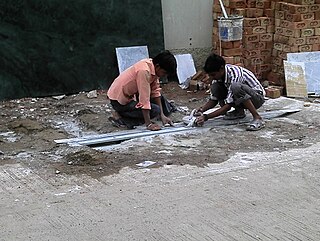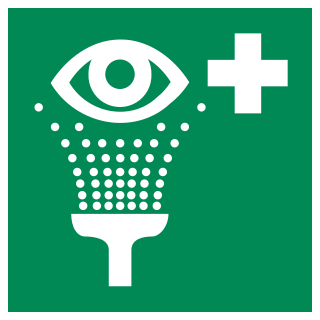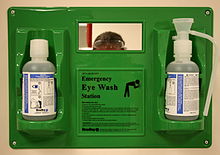The Occupational Safety and Health Administration is a regulatory agency of the United States Department of Labor that originally had federal visitorial powers to inspect and examine workplaces. The United States Congress established the agency under the Occupational Safety and Health Act, which President Richard M. Nixon signed into law on December 29, 1970. OSHA's mission is to "assure safe and healthy working conditions for working men and women by setting and enforcing standards and by providing training, outreach, education, and assistance." The agency is also charged with enforcing a variety of whistleblower statutes and regulations. OSHA's workplace safety inspections have been shown to reduce injury rates and injury costs without adverse effects on employment, sales, credit ratings, or firm survival.
Acute toxicity describes the adverse effects of a substance that result either from a single exposure or from multiple exposures in a short period of time. To be described as acute toxicity, the adverse effects should occur within 14 days of the administration of the substance.
Process Safety Managementof Highly Hazardous Chemicals is a regulation promulgated by the U.S. Occupational Safety and Health Administration (OSHA). It defines and regulates a process safety management (PSM) program for plants using, storing, manufacturing, handling or carrying out on-site movement of hazardous materials above defined amount thresholds. Companies affected by the regulation usually build a compliant process safety management system and integrate it in their safety management system. Non-U.S. companies frequently choose on a voluntary basis to use the OSHA scheme in their business.

Dangerous goods, abbreviated DG, are substances that when transported are a risk to health, safety, property or the environment. Certain dangerous goods that pose risks even when not being transported are known as hazardous materials. An example for dangerous goods is hazardous waste which is waste that has substantial or potential threats to public health or the environment.

Lock out, tag out or lockout–tagout (LOTO) is a safety procedure used to ensure that dangerous equipment is properly shut off and not able to be started up again prior to the completion of maintenance or repair work. It requires that hazardous energy sources be "isolated and rendered inoperative" before work is started on the equipment in question. The isolated power sources are then locked and a tag is placed on the lock identifying the worker and reason the LOTO is placed on it. The worker then holds the key for the lock, ensuring that only they can remove the lock and start the equipment. This prevents accidental startup of equipment while it is in a hazardous state or while a worker is in direct contact with it.
Hazardous Waste Operations and Emergency Response is a set of guidelines produced and maintained by the Occupational Safety and Health Administration which regulates hazardous waste operations and emergency services in the United States and its territories. With these guidelines, the U.S. government regulates hazardous wastes and dangerous goods from inception to disposal.
The General Duty Clause of the United States Occupational Safety and Health Act states:
Environment, health and safety (EHS) is the set that studies and implements the practical aspects of protecting the environment and maintaining health and safety at occupation. In simple terms it is what organizations must do to make sure that their activities do not cause harm to anyone. Commonly, quality - quality assurance and quality control - is adjoined to form the company division known as HSQE.
Right to know is a human right enshrined in law in several countries. UNESCO defines it as the right for people to "participate in an informed way in decisions that affect them, while also holding governments and others accountable". It pursues universal access to information as essential foundation of inclusive knowledge societies. It is often defined in the context of the right for people to know about their potential exposure to environmental conditions or substances that may cause illness or injury, but it can also refer more generally to freedom of information or informed consent.

Manual handling of loads (MHL) or manual material handling (MMH) involves the use of the human body to lift, lower, carry or transfer loads. The average person is exposed to manual lifting of loads in the work place, in recreational atmospheres, and even in the home. To properly protect one from injuring themselves, it can help to understand general body mechanics.

Hearing conservation programs are designed to prevent hearing loss due to noise. Hearing conservation programs require knowledge about risk factors such as noise and ototoxicity, hearing, hearing loss, protective measures to prevent hearing loss at home, in school, at work, in the military and, and at social/recreational events, and legislative requirements. Regarding occupational exposures to noise, a hearing conservation program is required by the Occupational Safety and Health Administration (OSHA) "whenever employee noise exposures equal or exceed an 8-hour time-weighted average sound level (TWA) of 85 decibels (dB) measured on the A scale or, equivalently, a dose of fifty percent." This 8-hour time-weighted average is known as an exposure action value. While the Mine Safety and Health Administration (MSHA) also requires a hearing conservation program, MSHA does not require a written hearing conservation program. MSHA's hearing conservation program requirement can be found in 30 CFR § 62.150, and is very similar to the OSHA hearing conservation program requirements. Therefore, only the OSHA standard 29 CFR 1910.95 will be discussed in detail.

A noise dosimeter or noise dosemeter is a specialized sound level meter intended specifically to measure the noise exposure of a person integrated over a period of time; usually to comply with Health and Safety regulations such as the Occupational Safety and Health (OSHA) 29 CFR 1910.95 Occupational Noise Exposure Standard or EU Directive 2003/10/EC.
The US National Institute for Occupational Safety and Health funds the Adult Blood Lead Epidemiology and Surveillance (ABLES) program, a state-based surveillance program of laboratory-reported adult blood lead levels. In 2009, the ABLES program updated its case definition for an Elevated Blood Lead Level to a blood lead concentration equal or greater than 10 micrograms per deciliter (10 μg/dL). This chart shows CDC/NIOSH/ABLES Elevated blood lead level case definition in perspective.
Nationally Recognized Testing Laboratory is the term used by the United States Occupational Safety and Health Administration to identify third-party organizations that have the necessary qualifications to perform safety testing and certification of products covered within OSHA and each organization's scopes. The testing and certification are conducted in accordance with U.S. consensus-based product safety test standards developed or issued by U.S. standards organizations
Workplace health surveillance or occupational health surveillance (U.S.) is the ongoing systematic collection, analysis, and dissemination of exposure and health data on groups of workers. The Joint ILO/WHO Committee on Occupational Health at its 12th Session in 1995 defined an occupational health surveillance system as "a system which includes a functional capacity for data collection, analysis and dissemination linked to occupational health programmes".

Manure management refers to capture, storage, treatment, and utilization of animal manures in an environmentally sustainable manner. It can be retained in various holding facilities. Animal manure can occur in a liquid, slurry, or solid form. It is utilized by distribution on fields in amounts that enrich soils without causing water pollution or unacceptably high levels of nutrient enrichment. Manure management is a component of nutrient management.
Accredited Crane Operator Certification OSHA regulation 29 CFR 1926 Subpart CC, released August 9, 2010, requires crane operators involved in construction to be certified by an accredited certification provider by November 10, 2014. An operator is defined as any person operating the equipment. To be accredited, certification providers must be accredited by a nationally recognized accrediting agency, defined as "an organization that, due to its independence and expertise, is widely recognized as competent to accredit testing organizations. Examples of such accrediting agencies include, but are not limited to, the National Commission for Certifying Agencies and the American National Standards Institute." This is the first time certification by an accredited certification provider has been required on a national level, although individual states and cities have required crane operator certification as far back as 2000. The new OSHA standards make the completion of this requirement an important topic of knowledge for the crane and lifting industry.
Operations Plus WMD is a training level in dealing with hazardous materials.
A GCM or ground continuity monitor is an electrical safety device that monitors the impedance to ground of a temporary electrical circuit and can provide indication in the event impedance rises to an unsafe value. A GCM is either an external testing device or a cord mounted device that measures the electrical continuity of a circuit’s path to ground.

An emergency eyewash and safety shower station are essential equipment for every laboratory that uses chemicals and hazardous substances. Emergency eyewash and safety shower stations serve the purpose of reducing workplace injury and keeping workers away from various dangers.







